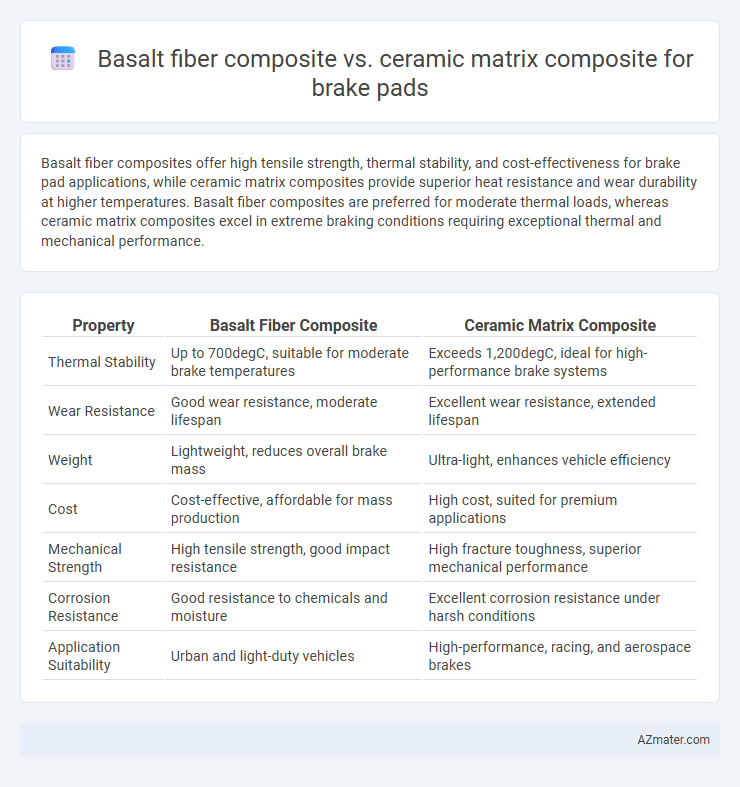Basalt fiber composites offer high tensile strength, thermal stability, and cost-effectiveness for brake pad applications, while ceramic matrix composites provide superior heat resistance and wear durability at higher temperatures. Basalt fiber composites are preferred for moderate thermal loads, whereas ceramic matrix composites excel in extreme braking conditions requiring exceptional thermal and mechanical performance.
Table of Comparison
| Property | Basalt Fiber Composite | Ceramic Matrix Composite |
|---|---|---|
| Thermal Stability | Up to 700degC, suitable for moderate brake temperatures | Exceeds 1,200degC, ideal for high-performance brake systems |
| Wear Resistance | Good wear resistance, moderate lifespan | Excellent wear resistance, extended lifespan |
| Weight | Lightweight, reduces overall brake mass | Ultra-light, enhances vehicle efficiency |
| Cost | Cost-effective, affordable for mass production | High cost, suited for premium applications |
| Mechanical Strength | High tensile strength, good impact resistance | High fracture toughness, superior mechanical performance |
| Corrosion Resistance | Good resistance to chemicals and moisture | Excellent corrosion resistance under harsh conditions |
| Application Suitability | Urban and light-duty vehicles | High-performance, racing, and aerospace brakes |
Introduction to Advanced Brake Pad Materials
Basalt fiber composites offer enhanced thermal stability and superior impact resistance compared to traditional materials, making them increasingly valuable in high-performance brake pad applications. Ceramic matrix composites excel in high-temperature environments due to their exceptional wear resistance and lightweight properties, enabling improved braking efficiency and extended pad lifespan. Both materials represent advancements in brake pad technology, balancing durability, thermal management, and environmental considerations for modern automotive and aerospace uses.
Overview of Basalt Fiber Composites
Basalt fiber composites are gaining popularity in brake pad applications due to their superior thermal stability, high mechanical strength, and excellent resistance to wear and corrosion compared to traditional materials. These composites consist of basalt fibers embedded in a polymer or resin matrix, offering enhanced durability and lightweight properties essential for efficient braking performance. Their environmental friendliness and cost-effectiveness further drive adoption in automotive and industrial brake systems.
Understanding Ceramic Matrix Composites
Ceramic matrix composites (CMCs) offer superior high-temperature resistance and wear durability compared to basalt fiber composites, making them ideal for advanced brake pad applications. CMCs consist of ceramic fibers embedded within a ceramic matrix, enhancing fracture toughness and thermal stability beyond traditional ceramic materials. Their low thermal expansion and excellent oxidation resistance contribute to consistent braking performance under extreme conditions, outperforming basalt fiber composites in longevity and safety.
Mechanical Properties Comparison
Basalt fiber composites exhibit high tensile strength and excellent impact resistance, making them suitable for brake pad applications requiring durability under dynamic stress. Ceramic matrix composites (CMCs) offer superior thermal stability and wear resistance with enhanced hardness, which is critical for maintaining performance at elevated temperatures during braking. Compared to basalt fiber composites, CMCs provide better compressive strength and oxidation resistance, resulting in longer service life and reliability in high-performance brake systems.
Thermal Stability and Heat Resistance
Basalt fiber composites exhibit excellent thermal stability with a decomposition temperature above 800degC, making them suitable for moderate thermal environments in brake pads. Ceramic matrix composites (CMCs) boast superior heat resistance, maintaining structural integrity at temperatures exceeding 1200degC, ideal for high-performance braking applications. The enhanced thermal conductivity and oxidation resistance of CMCs provide distinct advantages over basalt fiber composites in extreme thermal conditions.
Wear Resistance and Longevity
Basalt fiber composites exhibit superior wear resistance and enhanced longevity compared to traditional materials, making them effective for brake pad applications by providing consistent performance under high friction and thermal stress. Ceramic matrix composites (CMCs) offer exceptional thermal stability and resistance to degradation at elevated temperatures, which significantly extends brake pad lifespan in demanding environments. The choice between basalt fiber composites and CMCs depends on balancing cost efficiency, operational temperature ranges, and desired durability for optimal brake pad performance.
Weight and Density Differences
Basalt fiber composites offer a lower density of approximately 2.7-2.9 g/cm3, significantly reducing the overall weight of brake pads compared to ceramic matrix composites, which typically have densities around 3.9-4.3 g/cm3. This weight difference enhances vehicle efficiency by lowering unsprung mass, resulting in improved acceleration and fuel economy. Despite the higher density, ceramic matrix composites provide superior thermal stability and wear resistance essential for high-performance braking applications.
Cost and Manufacturing Considerations
Basalt fiber composites for brake pads offer lower raw material costs and simpler fabrication through conventional molding techniques, resulting in reduced overall production expenses compared to ceramic matrix composites (CMCs). CMCs demand high-temperature processing, specialized equipment, and precise quality control, significantly increasing manufacturing complexity and cost. The cost-effectiveness of basalt fibers makes them favorable for mass production, while CMCs are typically reserved for high-performance applications where superior thermal stability justifies the expense.
Environmental Impact and Sustainability
Basalt fiber composites offer significant environmental benefits for brake pads due to their natural mineral origin, low energy consumption during production, and excellent recyclability, reducing carbon footprint compared to synthetic alternatives. Ceramic matrix composites provide high thermal resistance and durability but involve energy-intensive processing and limited recyclability, which can increase environmental impact. Choosing basalt fiber composites enhances sustainability by minimizing hazardous waste and supporting eco-friendly manufacturing practices in automotive braking systems.
Conclusion: Choosing the Optimal Brake Pad Material
Basalt fiber composite offers excellent thermal stability, wear resistance, and cost-effectiveness, making it suitable for everyday brake pad applications with moderate performance demands. Ceramic matrix composites provide superior high-temperature strength, durability, and reduced brake fade, ideal for high-performance or heavy-duty braking systems despite their higher cost. Selecting the optimal brake pad material depends on balancing performance requirements, operating conditions, and budget constraints, with basalt composites favored for standard use and ceramic composites preferred for extreme environments.

Infographic: Basalt fiber composite vs Ceramic matrix composite for Brake pad
 azmater.com
azmater.com